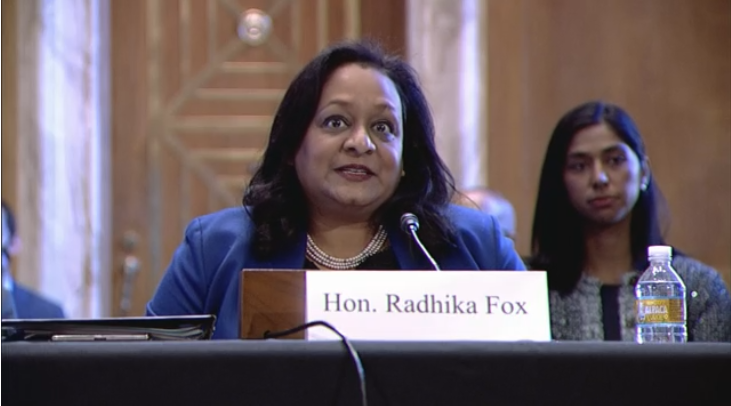WASHINGTON—The Environmental Protection Agency’s years-long implementation timeline for reducing the presence of potentially toxic chemicals into public drinking water concerned senators from both parties on Wednesday.
“In the roadmap, the length of time that this is going to take is very frustrating to me,” said ranking member Shelley Moore Capito, R-W.Va., during the Committee on Environment and Public Works hearing on the federal response to PFAS.
Known as “forever chemicals” because of their inability to break down in the environment, PFAS can be found in household items including nonstick cookware, food packaging and stain-resistant furniture.
“Why is it going to take so long when we know that the Office of Water can move more quickly?” the West Virginia Republican said.
Sen. Ben Cardin, D-Md., expressed similar sentiments, urging the EPA’s Assistant Administrator for Water Radhika Fox to “move as quickly as possible” in regulating PFAS.
“If we continue to delay these issues without being regulated appropriately, it’s going to be even more challenging in the future,” Cardin said, referring to PFAS.
Fox said she shares the senators’ frustration with the length of time required to execute the plan laid out in the PFAS roadmap, which EPA released on Monday.

Assistant Administrator for EPA’s Office of Water Radhika Fox said on Wednesday that she shared lawmakers’ frustration with the PFAS Roadmap timeline released by the agency on Monday. (Senate Committee on Environment and Public Works)
“Why it takes so long is that we have to follow the science and we have to follow the law,” Fox said.
The hearing comes on the heels of the Biden administration’s movement to regulate PFAS and to reduce their presence in public drinking water.
EPA Administrator Michael Regan laid out a comprehensive plan on Monday that would set legal limits for safe PFAS levels, aim to reduce PFAS contamination in the water supply and expand PFAS research efforts.
The Obama administration in 2016 implemented a recommended, but not mandated, health advisory limit of 70 parts per trillion for some PFAS chemicals in drinking water. However, a concentration of 70 ppt still poses a risk to public health, scientists have found.
Exposure to these substances has been linked to certain cancers, immune system problems and other health concerns.
Senators voiced concern over the impact of PFAS-contaminated water on the health of communities in their states.
Sen. Mark Kelly, D-Ariz., remarked that Arizona’s historic drought has already led to cuts in the amount of water the state receives from the Colorado River and said future reductions could force residents to rely on PFAS-contaminated groundwater.
“These competing challenges make mediating the PFAS plumes in Arizona’s aquifers an urgent priority,” Kelly said.
In Michigan, Sen. Debbie Stabenow, D-Mich., said the state “has had significant challenges” working with the Department of Defense to address PFAS contamination near military bases, where the chemicals have leached off the bases’ grounds and into lakes and other bodies of water.
“I’ve seen PFAS-contaminated foam floating across the lakes,” Stabenow said. “It’s terrible what is happening, it’s really frightening.”
The bipartisan infrastructure package and the Build Back Better plan could make significant contributions to help communities grappling with PFAS contamination, Fox said.
“For example, the $10 billion that is proposed in the bipartisan infrastructure bill…would be a gamechanger for communities in being able to do cleanups, making sure drinking water and wastewater systems are safe and PFAS-free. Those dollars are essential,” Fox said. “Communities have been waiting too long for these investments.”
A date for the bills’ passages is unclear as Democrats remain divided over the specifics of the legislation.

